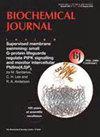Expression of neuronal NO synthase α- and β-isoforms in skeletal muscle of mice
IF 4.4
3区 生物学
Q2 BIOCHEMISTRY & MOLECULAR BIOLOGY
引用次数: 0
Abstract
Knowledge of the primary structure of neuronal NO synthase (nNOS) in skeletal muscle is still conflicting and needs further clarification. To elucidate the expression patterns of nNOS isoforms at both mRNA and protein level, systematic reverse transcription (RT)-PCR and epitope mapping by qualitative immunoblot analysis on skeletal muscle of C57/BL6 mice were performed. The ability of the nNOS isoforms to form aggregates was characterized by native low-temperature polyacrylamide electrophoresis (LT-PAGE). The molecular analysis was focused on the rectus femoris (RF) muscle, a skeletal muscle with a nearly balanced ratio of nNOS α- and β-isoforms. RT-PCR amplificates from RF muscles showed exclusive exon-1d mRNA expression, either with or without exon-μ. Epitope mapping demonstrated the simultaneous expression of the nNOS splice variants α/μ, α/non-μ, β/μ and β/non-μ. Furthermore, immunoblotting suggests that the transition between nNOS α- and β-isoforms lies within exon-3. In LT-PAGE, three protein nNOS associated aggregates were detected in homogenates of RF muscle and tibialis anterior muscle: a 320 kDa band containing nNOS α-isoforms, while 250 and 300 kDa bands consist of nNOS β-isoforms that form homodimers or heterodimers with non-nNOS proteins.小鼠骨骼肌中神经元 NO 合酶 α 和 β 异构体的表达
人们对骨骼肌中神经元 NO 合酶(nNOS)的主要结构的认识仍然存在冲突,需要进一步澄清。为了阐明 nNOS 同工酶在 mRNA 和蛋白质水平上的表达模式,研究人员对 C57/BL6 小鼠的骨骼肌进行了系统的反转录 (RT)-PCR 分析,并通过定性免疫印迹分析绘制了表位图。通过原生低温聚丙烯酰胺电泳(LT-PAGE)鉴定了 nNOS 异构体形成聚集体的能力。分子分析的重点是股直肌,这是一种 nNOS α 和 β 异构体比例几乎平衡的骨骼肌。来自 RF 肌肉的 RT-PCR 扩增片段显示了外显子-1d mRNA 的独家表达,有的有外显子-μ,有的没有外显子-μ。外显子图谱显示,nNOS剪接变体α/μ、α/non-μ、β/μ和β/non-μ同时表达。此外,免疫印迹表明,nNOS α 和 β 异构体之间的转换位于外显子 3 中。在 LT-PAGE 中,在射频肌肉和胫骨前肌的匀浆中检测到三种与 nNOS 相关的蛋白聚集体:320 kDa 的条带含有 nNOS α-异构体,而 250 和 300 kDa 的条带由 nNOS β-异构体组成,它们与非 nNOS 蛋白形成同二聚体或异二聚体。
本文章由计算机程序翻译,如有差异,请以英文原文为准。
求助全文
约1分钟内获得全文
求助全文
来源期刊

Biochemical Journal
生物-生化与分子生物学
CiteScore
8.00
自引率
0.00%
发文量
255
审稿时长
1 months
期刊介绍:
Exploring the molecular mechanisms that underpin key biological processes, the Biochemical Journal is a leading bioscience journal publishing high-impact scientific research papers and reviews on the latest advances and new mechanistic concepts in the fields of biochemistry, cellular biosciences and molecular biology.
The Journal and its Editorial Board are committed to publishing work that provides a significant advance to current understanding or mechanistic insights; studies that go beyond observational work using in vitro and/or in vivo approaches are welcomed.
Painless publishing:
All papers undergo a rigorous peer review process; however, the Editorial Board is committed to ensuring that, if revisions are recommended, extra experiments not necessary to the paper will not be asked for.
Areas covered in the journal include:
Cell biology
Chemical biology
Energy processes
Gene expression and regulation
Mechanisms of disease
Metabolism
Molecular structure and function
Plant biology
Signalling
 求助内容:
求助内容: 应助结果提醒方式:
应助结果提醒方式:


